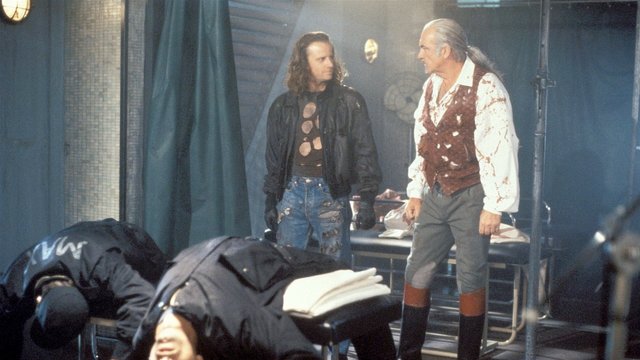
There are bad films, there are films considered to be the worst ever made, and then there are films that force their creators to take extreme measures in order to salvage their own reputations. One unfortunate victim of this is Russell Mulcahy, the Australian director who spent years and decades trying to rectify the damage caused by his 1991 science fantasy action film, Highlander II: The Quickening. This film is widely regarded as one of the most notoriously panned films in history.
Highlander II: The Quickening is the sequel to the popular 1986 film, Highlander, also directed by Mulcahy. Christopher Lambert reprises his role as Connor MacLeod, the last of the Immortals, who have battled each other for millennia. In the first film, Connor wins the Prize, which grants him human mortality and the ability to have children. The plot of the sequel picks up roughly four decades later in 2024 New York City, which is portrayed as a dystopian hellhole. Connor MacLeod, now an old and weary man, feels responsible for this state of affairs. In 1999, he used his powers to gather scientists and financial resources to build the Shield, which defended Earth from deadly solar radiation after the collapse of the ozone layer. While the Shield served its purpose, it also brought permanent darkness to the sky and made life miserable for most people. The Shield Corporation, led by the greedy and ruthless David Blake (played by John C. McGinley), profits immensely from this. A group of activists, led by former Shield employee Louise Marcus (played by Virginia Madsen), seeks to find proof that the ozone layer has actually recovered. Connor MacLeod becomes entangled in their mission due to events that took place long ago on a different world, where the Immortals originated and rebelled against the evil General Katana (played by Michael Ironside). Katana still sees Connor as a threat and sends assassins to kill him. However, their failed attempts trigger a quickening—a process that rejuvenates Connor and grants him the power to face Katana and assist Louise in her quest.
The problems for The Quickening began at the very beginning of production. The original film was conceived and made perfect sense as a standalone story that didn't require any sequels. If a sequel were to be made, the script needed to introduce something original while staying true to the Highlander fictional universe. Unfortunately, scriptwriter Peter Bellwood made a fatal mistake by providing the origin of Connor and the other Immortals as beings from another world—aliens from the planet Zeist in the original theatrical version and people from "long ago" in subsequent versions. This deviated from the established mythology of the previous film, but the even worse decision was to incorporate two major plot elements instead of one—the story about the Shield and Connor's battle against Katana. These two plots don't blend well and feature two rather underwhelming villains, portrayed by the lackluster John C. McGinley and Michael Ironside, who goes over the top.
However, Russell Mulcahy manages to do better work than the scriptwriters. While there are some scenes that he messes up, such as the absurdly and almost surrealistically violent subway train ride by Katana, most of the scenes are quite effective, displaying great attention to detail in terms of sets, lighting, and atmosphere. The film's visual style is a strange combination of Blade Runner and Tim Burton's Batman. Christopher Lambert, who was never a great actor, does his best given the circumstances, as does Virginia Madsen in the thankless role of eye candy. Sean Connery, despite his character Ramirez being killed in the first film, returns simply because his friend Lambert insisted on having him on set and the producers believed the film would fare better with his face on the poster. While his presence doesn't make much sense in the context of the film series' continuity, Connery becomes the best thing about the whole film. Although his role is essentially a glorified cameo, he seizes the opportunity to inject humor and prevent the audience from taking The Quickening too seriously. In fact, not taking this film seriously is the only way to enjoy the viewing experience.
Mulchay was fully aware of the problems The Quickening would face due to the chaotic production in Argentina, the excessively inflated budget, and the meddling of studio executives who ultimately took creative control. The original theatrical version was mercilessly criticized by critics, and many would argue that it deserved every bit of it. However, the film did manage to achieve decent results in the home video market. In 1995, Mulcahy released his own director's cut known as the Renegade Version, which made changes to the plot to make more sense and realign the film with the rest of the series. This was followed by the 2004 Special Edition, which used digital technology to enhance some of the special effects. Despite all these improvements, The Quickening remains inferior to the original and can only be enjoyed as a "guilty pleasure." Many hardcore fans of the Highlander franchise prefer to pretend that The Quickening was never made, and subsequent sequels and TV series starring Adrian Pasdar completely disregard its continuity. However, time has been somewhat kind to this film, as certain real-life ideas proposed by billionaires to combat global warming bear a disturbing resemblance to the plot of The Quickening, making the film strangely prophetic.
RATING: 5/10 (++)
Blog in Croatian: https://draxblog.com
Blog in English: https://draxreview.wordpress.com/
InLeo blog: https://inleo.io/@drax.leo
Unstoppable Domains: https://unstoppabledomains.com/?ref=3fc23fc42c1b417
Hiveonboard: https://hiveonboard.com?ref=drax
Bitcoin Lightning HIVE donations: https://v4v.app/v1/lnurlp/qrcode/drax
Rising Star game: https://www.risingstargame.com?referrer=drax
1Inch: https://1inch.exchange/#/r/0x83823d8CCB74F828148258BB4457642124b1328e
BTC donations: 1EWxiMiP6iiG9rger3NuUSd6HByaxQWafG
ETH donations: 0xB305F144323b99e6f8b1d66f5D7DE78B498C32A7
Five? You were too generous in this case, @drax.
Downvoting a post can decrease pending rewards and make it less visible. Common reasons:
Submit
I guess the original version was so bad that this one looked like an epic improvement.
Downvoting a post can decrease pending rewards and make it less visible. Common reasons:
Submit